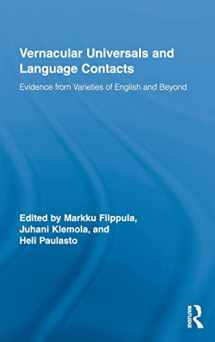
Vernacular Universals and Language Contacts: Evidence from Varieties of English and Beyond (Routledge Studies in Germanic Linguistics)
ISBN-13:
9780415992398
ISBN-10:
0415992397
Edition:
1
Author:
Markku Filppula, Juhani Klemola, Heli Paulasto
Publication date:
2008
Publisher:
Routledge
Format:
Hardcover
386 pages
Category:
Grammar
,
Words, Language & Grammar
,
Linguistics
FREE US shipping
Book details
ISBN-13:
9780415992398
ISBN-10:
0415992397
Edition:
1
Author:
Markku Filppula, Juhani Klemola, Heli Paulasto
Publication date:
2008
Publisher:
Routledge
Format:
Hardcover
386 pages
Category:
Grammar
,
Words, Language & Grammar
,
Linguistics
Summary
Vernacular Universals and Language Contacts: Evidence from Varieties of English and Beyond (Routledge Studies in Germanic Linguistics) (ISBN-13: 9780415992398 and ISBN-10: 0415992397), written by authors
Markku Filppula, Juhani Klemola, Heli Paulasto, was published by Routledge in 2008.
With an overall rating of 3.9 stars, it's a notable title among other
Grammar
(Words, Language & Grammar , Linguistics) books. You can easily purchase or rent Vernacular Universals and Language Contacts: Evidence from Varieties of English and Beyond (Routledge Studies in Germanic Linguistics) (Hardcover) from BooksRun,
along with many other new and used
Grammar
books
and textbooks.
And, if you're looking to sell your copy, our current buyback offer is $0.3.
Description
In this book, contributors have been brought together to discuss the role of two major factors shaping the grammars of different varieties of English (and of other languages) all over the world: so-called vernacular universals and contact-induced change. Rather than assuming a general typological perspective, the studies in this volume focus on putative universal vernacular features – significant phonological or (morpho-) syntactic parallels found in non-standard varieties of English, English-based Creoles, and also varieties of other languages, all of which represent widely differing sociolinguistic and historical backgrounds. These universals are then set against the other major explanatory factor: contact-induced change, by which we understand both the possibility of dialect contact (or dialect diffusion) and language contact (including superstratal, substratal and adstratal influences).


We would LOVE it if you could help us and other readers by reviewing the book
Book review

Congratulations! We have received your book review.
{user}
{createdAt}
by {truncated_author}


